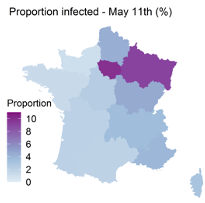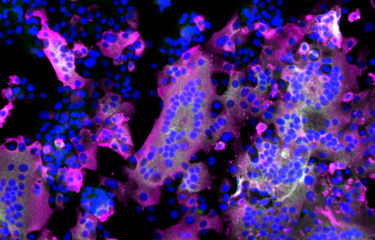The SARS-CoV-2 global pandemic has resulted in extreme measures, with several countries imposing a lockdown on their residents. Like much of the rest of Europe, France has been badly affected by the outbreak; it introduced lockdown measures on March 17 with the aim of significantly reducing the circulation of the virus among the population. To help understand and manage this unprecedented health situation, it is vital to be able to estimate the level of circulation of the virus among the population, to evaluate the risk of developing a severe form of the disease and to identify indicators that measure the impact of the steps currently being taken against the outbreak. Scientists from the Institut Pasteur and the CNRS, in collaboration with Inserm, DREES and Santé Publique France, have conducted a detailed analysis of hospitalizations and deaths from COVID-19 in France and developed models based on these data. Initial results suggest that between 3% and 7% of the French population will have been contaminated by SARS-CoV-2 by May 11th. The reproduction number (R), which indicates the number of people that will catch the disease from each infected individual, has fallen from 2.9 at the beginning of the lockdown to 0.7. These results were pre-published on the Institut Pasteur online archive website on April 21th, 2020. They were published in Science on May 13th, 2020.
The COVID-19 pandemic is taking a heavy toll on many European countries, and France is no exception, with more than 26,000 deaths as of May 11th, 2020. On March 17, the French government imposed a nationwide lockdown in a bid to stop the virus spreading and prevent intensive care units from being overwhelmed. Developing a lockdown exit strategy involves evaluating the impact of this unprecedented measure on the transmission of the SARS-CoV-2 virus and improving our understanding of the risk that infected individuals will develop a severe form. It is also vital to discern the level of immunity in the French population to assess the risk of a second wave of the outbreak.
Scientists from the Institut Pasteur and the CNRS, in collaboration with Inserm and Santé Publique France, set out to answer these questions by conducting a detailed analysis of hospitalizations and deaths from COVID-19 in France. These data only describe the most severe infections. To trace the development of the total number of infections in France, including mild cases, the scientists analyzed the data on hospitalizations in France in conjunction with the results of epidemiological surveys that characterize the risk of death for those infected with SARS-CoV-2.
This data integration process required the use of mathematical and statistical modeling tools. "At a time of great uncertainty, these model-based analyses can help improve our understanding of the outbreak and how the lockdown has affected the spread of SARS-CoV-2," explains Simon Cauchemez, Head of the Mathematical Modeling of Infectious Diseases Unit at the Institut Pasteur and last author of the study.
The results show that in France, the risk of hospitalization is 3.6% for those infected with SARS-CoV-2.
The death rate among infected individuals is approximately 0.7% (17% in men over the age of 80). The probability of death is 47% higher in hospitalised men than hospitalised women.
The analysis also shows that the lockdown has had a major impact on the spread of SARS-CoV-2, reducing the reproduction number of the virus by 77%. The average number of people infected for every case, known as, the reproductive number, R, has fallen from 2,9 to 0.67 during the lockdown. This led to a drop in the daily number of intensive care admissions from 700 in late March to 66 as of May 7th, 2020.
By May 11th, 2020, it is estimated that between 3% and 7% of French people will have been infected by SARS-CoV-2, with a higher proportion in the Greater Paris (between 7% and 16%) and Grand Est regions (between 6% and 15%)
This level of immunity is therefore far lower than the level needed to avoid a second wave if all the control measures are lifted. The required level of "herd immunity" is currently estimated at 66%. So considerable efforts will still be needed after May 11 to avoid a resurgence of the outbreak.

Estimate of the percentage, by region in France, of people infected with SARS-CoV-2, by May 11, 2020
Update of May 19th, 2020
Source
Estimating the burden of SARS-CoV-2 in France, Science, 13 mai 2020
Henrik Salje1,2,3, Cécile Tran Kiem1,4, Noémie Lefrancq1, Noémie Courtejoie5, Paolo Bosetti1, Juliette Paireau1,6, Alessio Andronico1, Nathanaël Hozé1, Jehanne Richet5, Claire-Lise Dubost5, Yann Le Strat6, Justin Lessler3, Daniel Levy Bruhl6, Arnaud Fontanet7,8, Lulla Opatowski9,10, Pierre-Yves Boelle11, Simon Cauchemez1
1. Mathematical Modelling of Infectious Diseases Unit, Institut Pasteur, UMR2000, CNRS, France
2. Department of Genetics, University of Cambridge, Cambridge, UK
3. Department of Epidemiology, Johns Hopkins Bloomberg School of Public Health, Baltimore, Maryland, USA
4. Collège Doctoral, Sorbonne Université, Paris, France
5. DREES, Ministère des Solidarités et de la Santé, Paris, France
6. Santé Publique France, French National Public Health Agency, Saint-Maurice, France
7. Emerging Diseases Epidemiology Unit, Institut Pasteur, Paris, France
8. PACRI Unit, Conservatoire National des Arts et Métiers, Paris, France
9. Epidemiology and Modelling of Antibiotic Evasion Unit, Institut Pasteur, Paris, France
10. Anti-infective evasion and pharmacoepidemiology team, CESP, Université Paris-Saclay, UVSQ, INSERM U1018, Montigny-le-Bretonneux, France.
11. Sorbonne Université, INSERM, Institut Pierre Louis d’Epidémiologie et de Santé Publique, Paris, France





